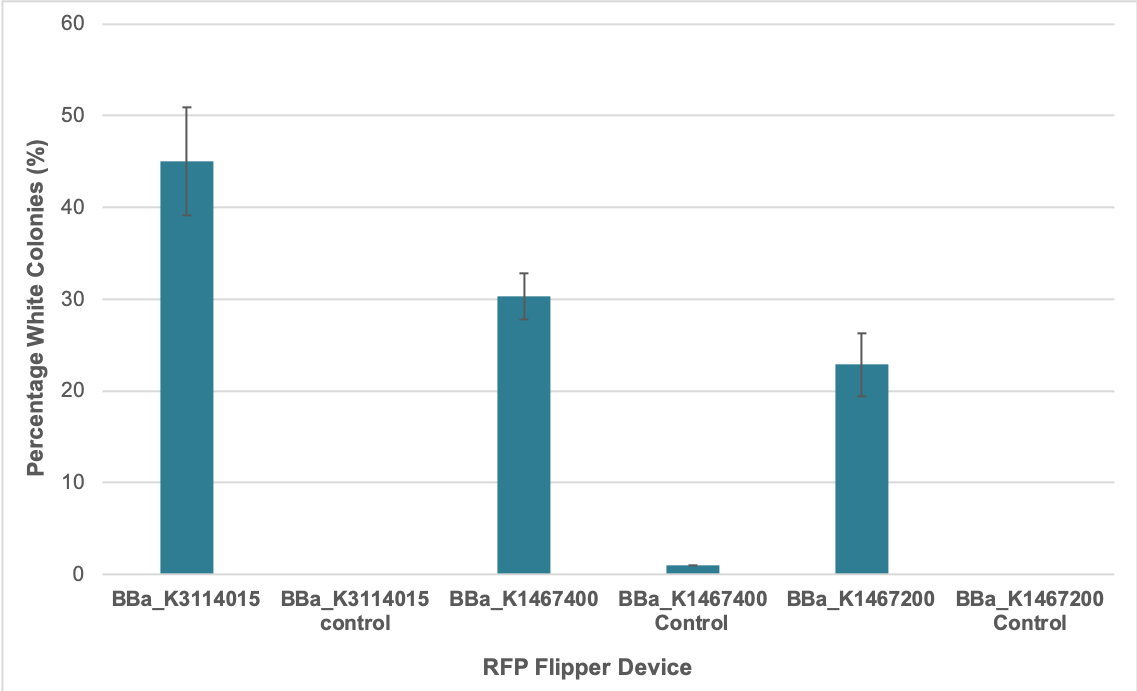Part:BBa_K3114015
Improved RFP coding device - Golden Gate Module Flipper
This is an improvement of part BBa_K1467400
Usage and Biology
This part is a Golden Gate flipper with an RFP device, flanking inverted BsaI sites, and fusion sites compatible with the MoClo assembly standard. This part can be used to convert entire transcriptional units from the Golden Gate MoClo assembly standard into standard BioBricks. It can also be used to convert any BioBrick RFC[10]-compatible vector to a Golden Gate destination vector.
This part has been improved from BBa_K1467400 by substituting the LacI-regulated promoter (BBa_R0010) with a strong constitutive promoter (BBa_J23100). We also exchanged the RBS for a stronger one.
This part allows for colony screening following Golden Gate reactions. Colonies containing the correct assembly should be white in appearance, as the Golden Gate modules will have replaced the RFP device in the vector. Unsuccessful colonies should be red under UV and natural light.
Design
The substitutions that we made in the RFP device were intended to maximize RFP expression and decrease the amount of time required to observe if the colonies are red. The strong constitutive promoter BBa_J23100 and strong RBS BBa_B0030 were chosen because they are very well-characterized.
We also codon optimized this part for high expression in E. coli.
Characterization
iGEM Calgary used this part to convert pSB1A3 to our Golden Gate destination vector. The synthesized sequence was first cloned into linearized pSB1A3 using an EcoRI + PstI digestion and ligation. The product was sequence confirmed. Following this, we successfully used the part as our destination vector to create six genetic constructs via Golden Gate assembly.
We determined the average percentage of successful assembly for our improved part BBa_K3114015 as well as the original BBa_K1467400 based on the proportion of white colonies following transformation of Golden Gate assembly samples. Colonies will only become white in appearance (rather than red) if the insert DNA has replaced the RFP coding device between the BsaI sites, and has been assembled in the correct order to allow for successful ligation.
Golden Gate assembly reactions were set up to each contain the same amount of destination vector and required DNA inserts in the form of PCR products. A 1:1 insert:destination vector ratio was used in each reaction. They were conducted as per our Golden Gate assembly protocol. As per the overhang/fusion site sequences associated with the BsaI restriction sites in BBa_K3114015 and BBa_K1467400, they were used in four-insert assembly reactions using parts:
The other RFP Golden Gate flipper (BBa_K1467200) that we characterized features overhang/fusion site sequences associated with the BsaI restriction sites that necessitated two-insert assembly reactions using parts:
The Golden Gate assembly products were transformed into E. coli DH5-alpha. Some colonies became visibly red under normal light after 12 hours for the improved part BBa_K3114015 and after 18 hours for BBa_K1467400 and the other RFP device Golden Gate flipper (BBa_K1467200). We counted the number of red versus white colonies for each of the replicates 24 hours after transformation. The results suggest that using the improved RFP flipper BBa_K3114015 resulted in a higher percentage of successful assembly reactions compared to the original RFP flipper BBa_K1467400. However, the mechanism behind this is unclear.

Sequences and Features
- 10COMPATIBLE WITH RFC[10]
- 12INCOMPATIBLE WITH RFC[12]Illegal NheI site found at 18
Illegal NheI site found at 41 - 21COMPATIBLE WITH RFC[21]
- 23COMPATIBLE WITH RFC[23]
- 25INCOMPATIBLE WITH RFC[25]Illegal AgeI site found at 629
Illegal AgeI site found at 741 - 1000INCOMPATIBLE WITH RFC[1000]Illegal BsaI site found at 882
Illegal BsaI.rc site found at 6
//function/reporter
//function/reporter/color
//function/reporter/fluorescence
//plasmid/construction
| None |

